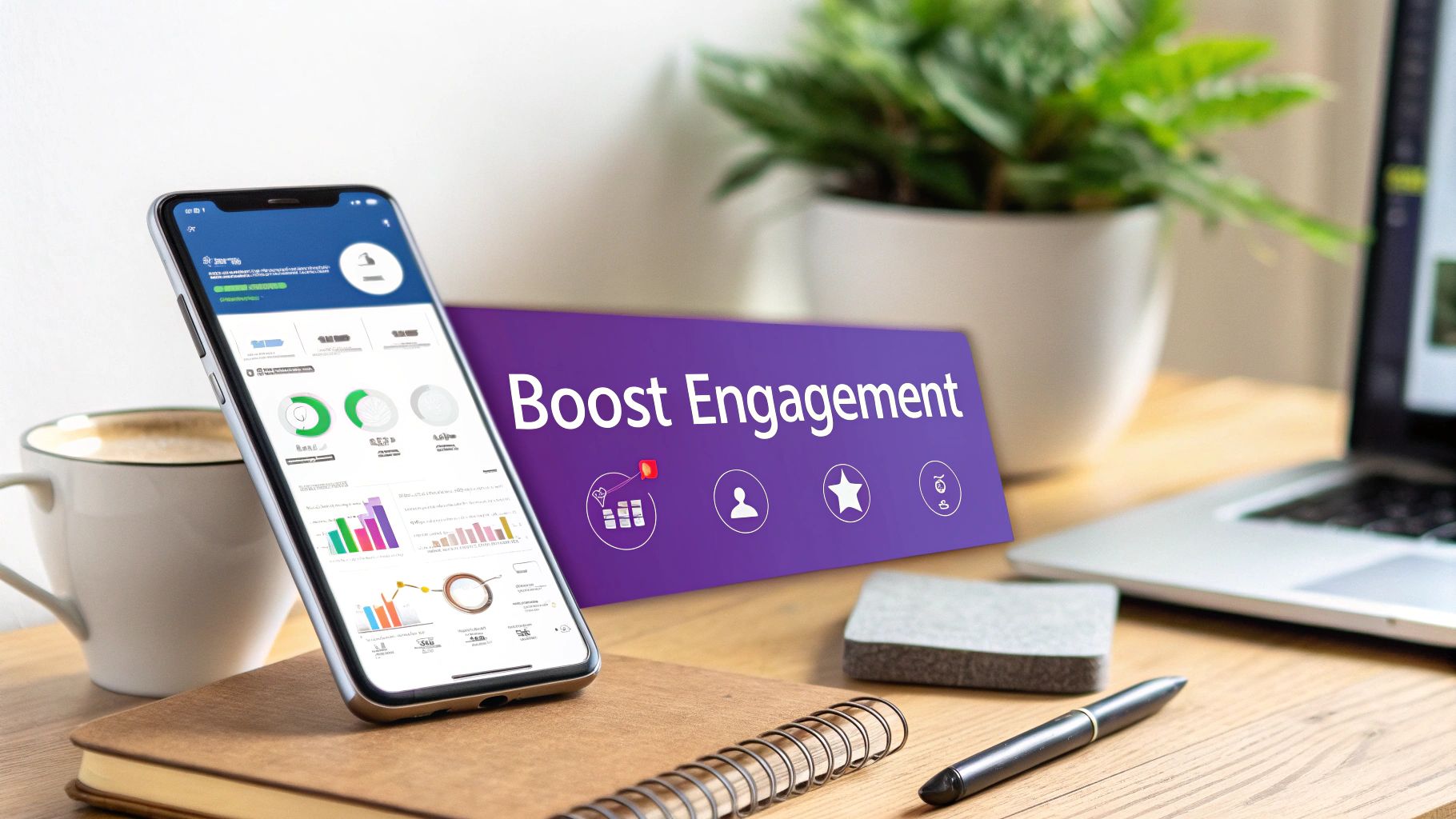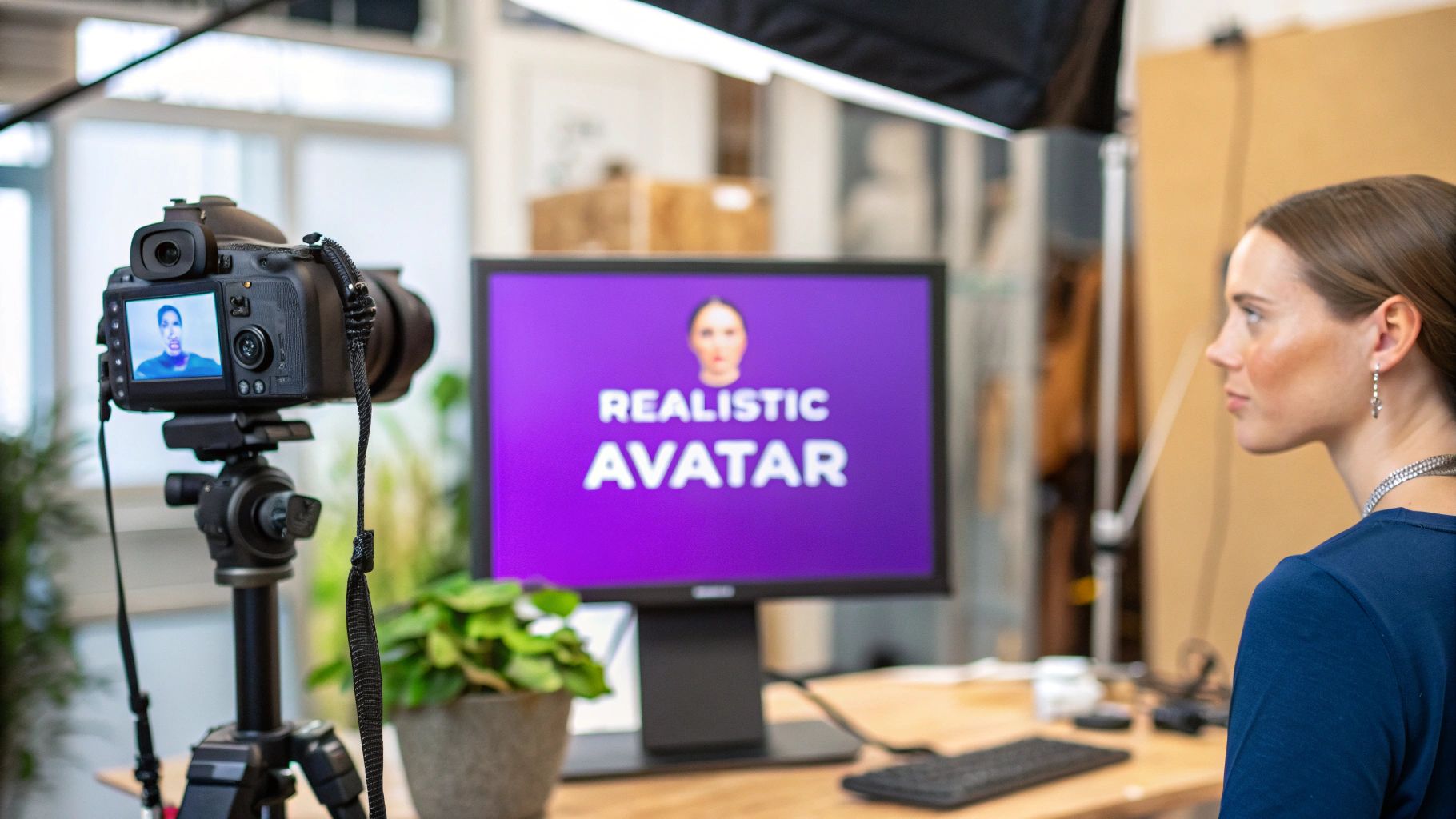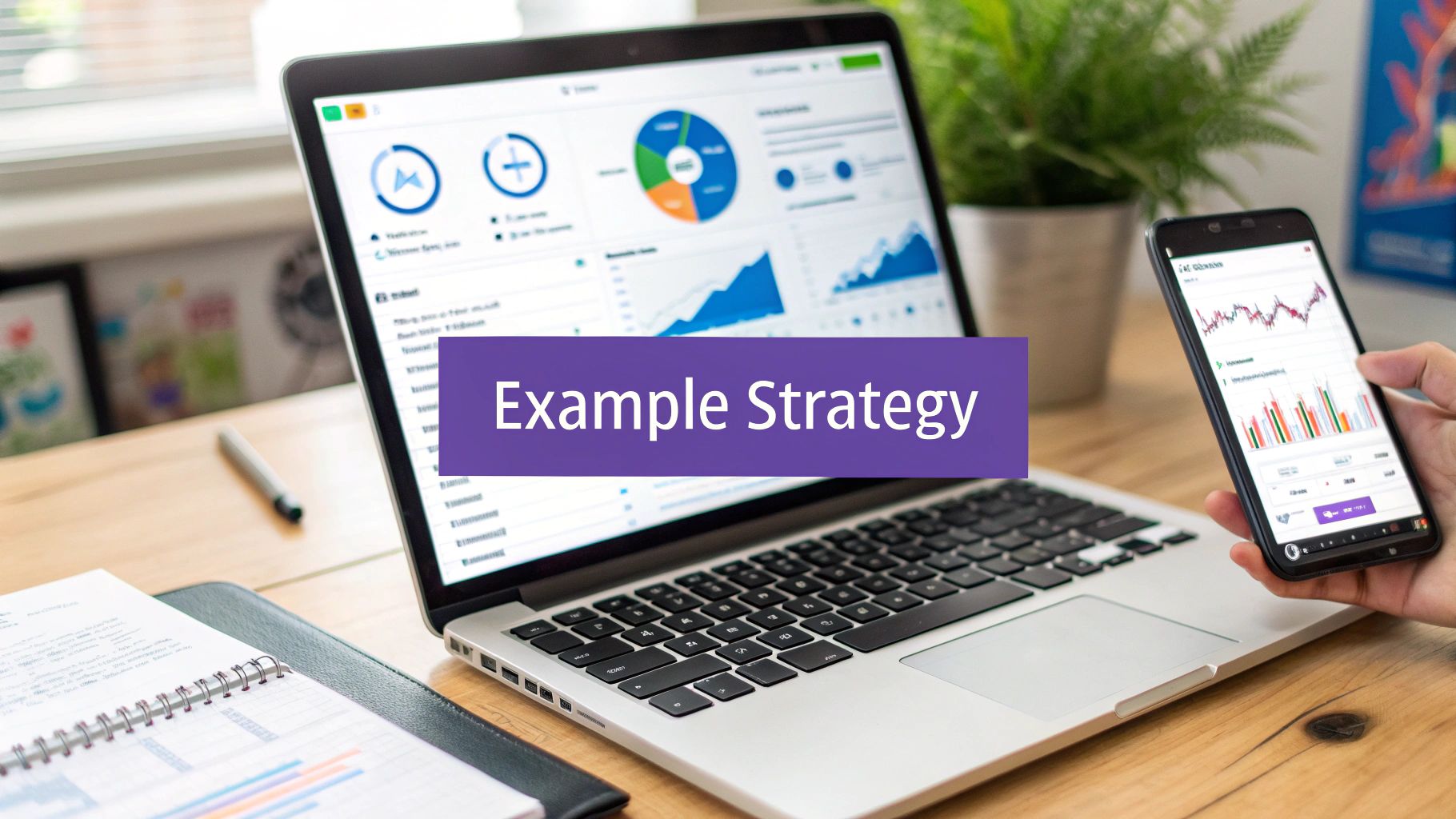Small Business Social Media Strategy: Boost Your Growth
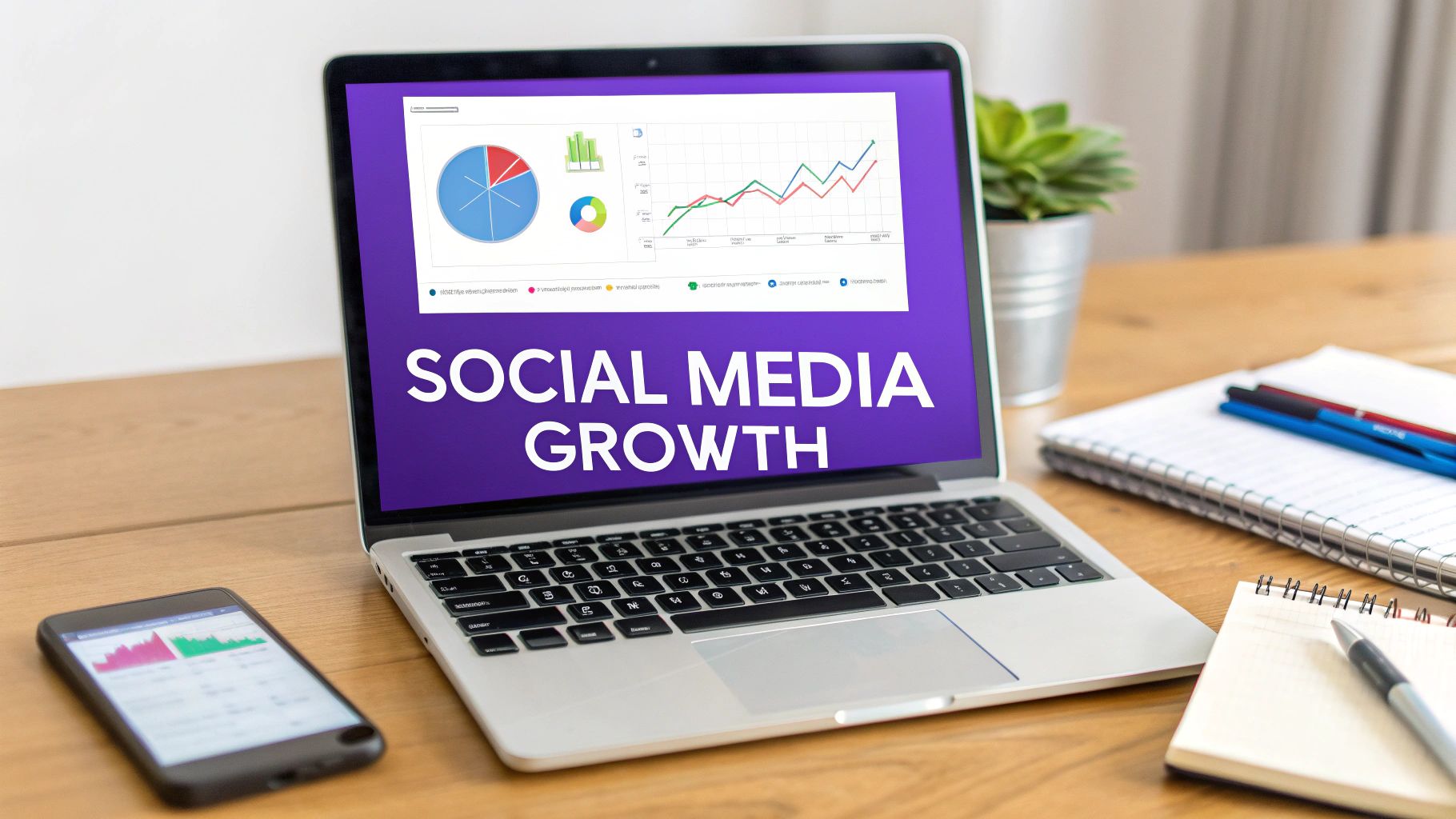
A small business social media strategy isn't just about posting pretty pictures. It’s a concrete plan that ties your content directly to your business goals, making sure every single post serves a purpose. It’s the difference between randomly shouting into the void and building a predictable engine for growth.
Build Your Strategy on a Solid Foundation
Jumping onto social media without a plan is like setting sail without a map. Sure, you might float around for a bit, but you’ll never reach a specific destination. Before you even think about crafting that first post, you need to build a solid foundation. This is what separates businesses that post on a whim from those that create a reliable system for attracting customers.
This whole process starts with a simple social media audit. An audit is just a fancy word for taking stock of where you are right now. What’s working? What’s a total flop? Where are the hidden opportunities? Don’t overthink it. A quick, honest look at your current presence can bring a ton of clarity.
Define Your Goals and Purpose
After you’ve sized up your current situation, it's time to set clear, measurable goals. Vague ideas like "get more followers" are practically useless. Instead, think in terms of SMART goals (Specific, Measurable, Achievable, Relevant, Time-bound) that connect your social media efforts to actual business outcomes.
For example, a new local bakery’s goal isn't just "to be on Instagram." A much better, more strategic goal would be: "Increase local brand awareness by hitting 15,000 impressions per month on Instagram and driving 50 weekly clicks to our online ordering page within the next three months."
This simple flow shows how your goals, content, and analysis should work together in a continuous cycle.
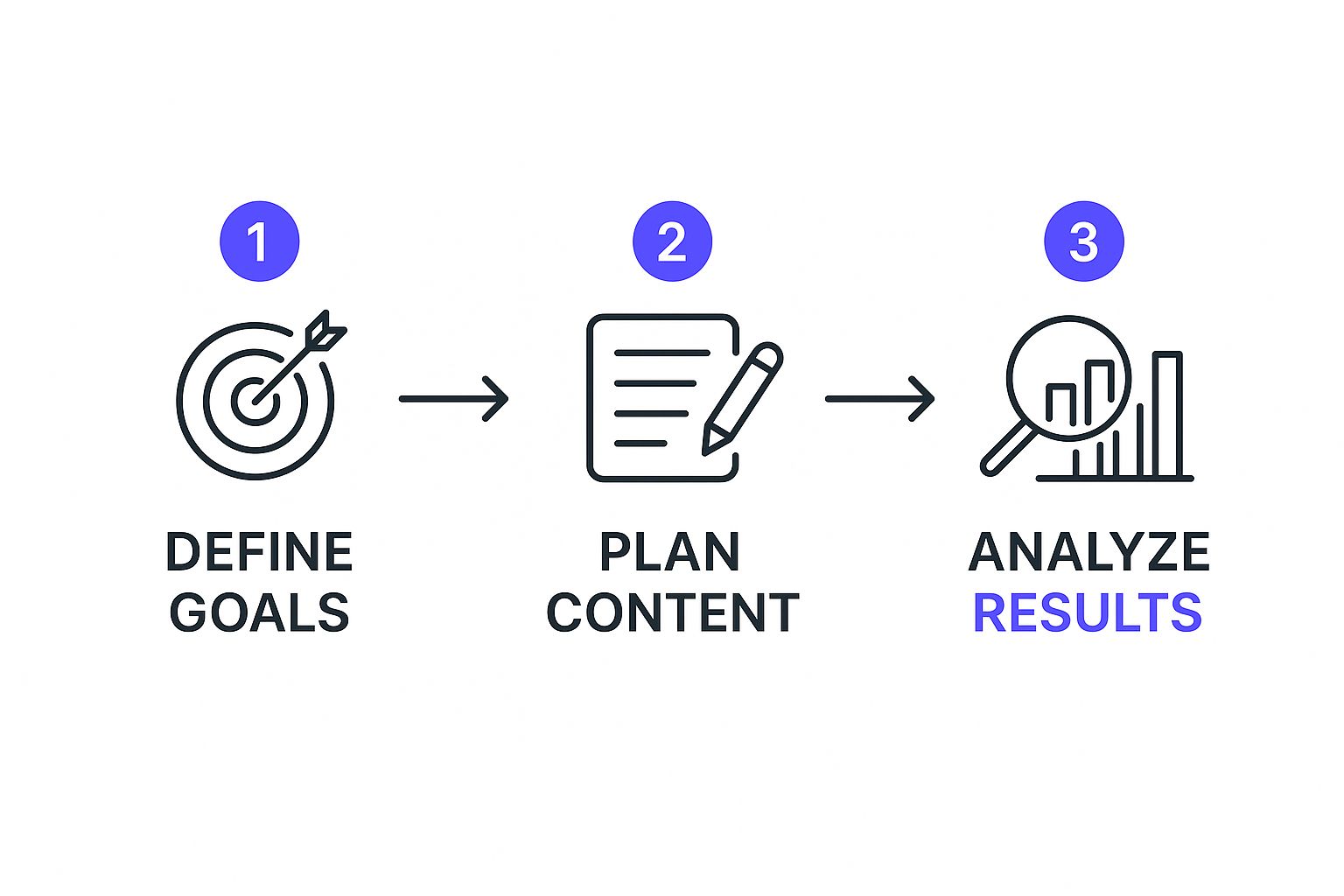
As you can see, a winning strategy isn't something you set up once and forget. It's a constant loop of planning, doing, and refining.
This approach has never been more critical. As of 2025, a staggering 96% of small businesses worldwide are using social media for marketing, showing just how essential it has become. With over 5 billion active users scrolling for more than two hours a day, the potential is enormous—but so is the noise.
Key Takeaway: A strategy without goals is just noise. Your goals dictate the platforms you choose, the content you create, and the metrics you track. They are the north star for your entire small business social media strategy.
Conduct a Practical Social Media Audit
The word "audit" can sound intimidating, but it’s really just about asking some honest questions to figure out what's actually working.
To get a clearer picture of where your small business stands, a quick audit is the perfect starting point. The checklist below will help you gather the essential information needed to make smarter decisions about your social media strategy.
Initial Social Media Audit Checklist
| Audit Area | Key Question to Ask | Example Action |
|---|---|---|
| Platform Performance | Which channel brings the most engagement or website traffic? | Focus more resources on Instagram if it drives more sales than your dormant X profile. |
| Content Wins & Losses | Which posts from the last month got the most comments? Which fell flat? | Create more behind-the-scenes videos if they consistently outperform static images. |
| Audience Alignment | Do your followers' demographics match your ideal customer? | Adjust content to appeal to a younger demographic if your audience data shows a mismatch. |
| Profile Consistency | Is your branding (logo, bio, tone) consistent across all platforms? | Update all profile pictures and bios to reflect your current brand messaging. |
This quick check-up gives you a baseline, helping you see what to double down on and what to cut loose. It’s a vital first step to https://blog.makerbox.io/enhance-online-presence and stop wasting time on things that don't move the needle.
To really build something that connects with people, it's worth diving into a full-blown content strategy for social media marketing. This foundational work ensures every post serves a purpose, turning your social media from a time-sink into a true business asset.
Choose Social Media Platforms That Actually Work

The old advice to “be everywhere” on social media is a surefire recipe for burnout, especially if you're running a small business. A much smarter small business social media strategy is to put your energy where it will actually make a difference. This means looking past a platform's total user count and digging into where your ideal customers are really spending their time and, more importantly, are open to hearing from you.
Think of it like fishing. You wouldn’t just cast a line into any random body of water and hope for the best. You'd go to the specific spot where you know the fish you want to catch are swimming. The same logic applies here.
Understand the Mindset Behind Each Platform
Every social network has its own unique vibe and user expectations. Getting a feel for this is crucial for picking the right channels and creating content that lands well instead of falling flat. Someone scrolling through LinkedIn is in a professional, career-oriented headspace, while a user on TikTok is there for quick, entertaining, and often trend-driven videos.
Let's break down the major players by the typical mindset of their users:
- Facebook: Think of it as the digital town square. People are here to connect with friends and family, join groups around shared interests, and find local businesses and events. It’s fantastic for building a community and running targeted local ads.
- Instagram: This is the visual lookbook. It’s all about aesthetics, storytelling, and inspiration. Users are in discovery mode, searching for beautiful products, lifestyle ideas, and behind-the-scenes glimpses.
- LinkedIn: The professional water cooler. The vibe is all about career development, B2B networking, and industry news. Content is expected to be insightful, professional, and informative.
- TikTok: It's the ultimate entertainment machine. Users want raw, creative, and fast-paced videos that either entertain them or teach them something new in seconds. Authenticity and jumping on trends are everything here.
- Pinterest: This is the digital vision board. Users are actively planning and searching for ideas—from recipes and home decor to fashion and wedding inspiration. They are in a future-focused, purchasing mindset, which makes it incredibly powerful for visual products.
Matching your business to the platform's core purpose is a critical first step. A B2B software company will almost certainly get more traction sharing industry reports on LinkedIn than by attempting dance challenges on TikTok. On the flip side, a local boutique can absolutely kill it on Instagram's visual-first format.
Research Your Audience’s Digital Footprint
Making an educated guess is a great start, but data makes it better. And you don't need a huge research budget to figure this out. Your existing customers are a goldmine of information.
A simple way to start is by surveying your current customers. A one-question poll in your next email newsletter asking, "Which social media platform do you use most often?" can give you incredible clarity. You can also peek at your website analytics to see which social channels are already sending referral traffic your way.
Expert Tip: Don't just ask where they are; ask why they use a platform. Knowing they use Facebook for family updates but Instagram for shopping inspiration helps you tailor the purpose of your content for each channel.
This kind of research stops you from pouring time and money into a platform just because it’s popular. For example, while TikTok has a massive user base, if your target customer is a 55-year-old CEO, your resources are almost definitely better spent on LinkedIn. Data from Sprout Social shows that 81% of consumers use social media to shop for their next purchase, but where they shop depends heavily on their age, interests, and habits.
Compare Platforms for Your Business Type
To make this more concrete, let's look at how different types of businesses might pick their primary platforms. This table shows how you can apply the "mindset" framework to a real-world small business social media strategy.
| Business Type | Primary Platform(s) | Why It Works |
|---|---|---|
| Local Coffee Shop | Instagram & Facebook | Perfect for sharing daily specials, aesthetic photos of coffee art, and running hyper-local ads to drive foot traffic. |
| B2B Marketing Consultant | LinkedIn & X (Twitter) | Ideal for sharing industry insights, case studies, and networking with potential clients in a professional context. |
| Handmade Jewelry Etsy Shop | Pinterest & Instagram | These visual platforms are essential for showcasing product beauty and inspiring potential buyers who are in a discovery and shopping mindset. |
| Personal Fitness Coach | TikTok & Instagram | Excellent for sharing quick workout tips, client transformations (with permission), and building a personal brand through engaging video content. |
By choosing just two, or at most three, core platforms, you can go deep instead of wide. This focus allows you to create content that’s perfectly suited for that channel's audience, engage meaningfully with your community, and truly master the platform’s features. Spreading yourself too thin with generic content everywhere just doesn't work. This focused approach is the real secret to building a social media presence that actually generates a return.
Create Content That Builds a Loyal Community
Having the right platforms is just step one. Now, let's talk about the real work: creating content that people actually want to see, share, and discuss. A winning social media strategy for a small business isn't about shouting "buy my stuff!" into the void. It’s about building a community that genuinely trusts and likes your brand.
This means every single post needs to offer some kind of value. It could be educational, entertaining, or just plain inspiring.
This is where you graduate from random posting to building a content engine. The heart of this engine is a set of content pillars—two or three core topics that your brand can own. These pillars should sit squarely at the intersection of what your audience cares about and what your business knows best.
Think of them as the main chapters of your brand’s story. For a local coffee shop, the pillars might be:
- The art of coffee making (educational).
- Community spotlights (featuring local regulars and events).
- Behind-the-scenes at the shop (building that personal connection).
These pillars keep your content focused and valuable, saving you from that daily "what on earth do I post today?" panic. They also teach your audience what to expect from you, which is how loyalty is built.
Develop a Distinct Brand Voice
How you say something is just as important as what you say. Your brand voice is the personality your business shows through its words, and to work, it has to feel real. Are you witty and informal? Or maybe more buttoned-up and authoritative? There's no wrong answer, but you absolutely have to be consistent.
A great way to pin this down is to imagine your brand is a person. What are three adjectives that describe them? For example, a financial advisor targeting millennials might go for: empowering, straightforward, and approachable. This simple exercise guides every caption, comment reply, and video script, making sure your brand’s personality shines through consistently.
A strong brand voice is what turns passive followers into an active community. When people feel like they know the personality behind the logo, they're more likely to engage, trust you, and eventually become loyal customers.
Authenticity is more critical than ever. The pivot to video content is undeniable: 78% of consumers prefer learning about products through short videos. It's no surprise that 93% of marketers plan to ramp up their social media efforts in 2025, with a heavy focus on formats like Stories, Reels, and live streams. But here's the catch: as AI-generated content floods our feeds, platforms are rewarding authentic, conversation-starting engagement over old-school broadcasting. You can get a deeper dive into these trends in a detailed social media statistics report from Sprout Social.
Diversify Your Content Formats
With your pillars and voice figured out, it's time to think about how you'll deliver your message. Sticking to one format, like static images, gets stale fast. Mixing up your content keeps your audience on their toes and lets you tell your story in more compelling ways.
Here are a few formats you should get comfortable with:
- Short-Form Video (Reels, TikToks, Shorts): This is non-negotiable now. Create quick, snappy videos that either teach or entertain. A local bookstore could film a Reel on "3 Books to Read When You're Feeling Stuck."
- Behind-the-Scenes Content: Pull back the curtain and show the human side of your business. Post Stories of your team setting up for an event or a quick video of you unboxing new products. This stuff builds trust and makes your brand feel more human.
- User-Generated Content (UGC): Get your customers involved! Encourage them to share photos or videos with your products. When you reshare their posts, it acts as powerful social proof and shows you truly value your community.
- Educational Carousels: Use Instagram's carousel feature to break down a bigger idea into easy-to-digest slides. A personal trainer could make a carousel on "5 Common Squat Mistakes and How to Fix Them."
You don’t need a Hollywood budget. Your smartphone, some decent lighting, and a clear idea are often all it takes. If you’re ever stuck, check out our giant list of social media content ideas to keep your calendar packed.
Move Beyond Selling to Connecting
The most successful small businesses on social media prioritize connection way more than conversion in their day-to-day content. Yes, the ultimate goal is to drive sales, but your feed shouldn't feel like a 24/7 commercial.
A good rule to live by is the 80/20 rule: 80% of your content should provide value (educate, entertain, inspire), and only 20% should be directly promotional.
For instance, a skincare brand might post:
- An educational carousel on the benefits of Vitamin C (Value).
- A fun Reel of a morning skincare routine (Value).
- A customer testimonial video (Value).
- A post announcing their new Vitamin C serum is on sale (Promotional).
This approach builds a real relationship with your audience. So when you finally ask for the sale, they're far more likely to listen. You're not just another company trying to sell them something; you're a trusted resource they've come to know and like. This is how you turn followers into a loyal community that sticks around for the long haul.
Stay Consistent with a Simple Content Calendar

Let's be real: the single most important part of any small business social media strategy is consistency. Posting sporadically kills your momentum and leaves your audience wondering if you're still in business. The secret weapon that turns social media from a daily, reactive chore into a proactive, manageable system is a good old-fashioned content calendar.
A content calendar isn't about boxing yourself into a rigid, soulless plan. It's the exact opposite. It's a framework that gives you freedom. When you plan ahead, you kill that last-minute panic of "What should I post today?" and ensure your content is thoughtful, aligned with your goals, and genuinely valuable.
Map Out Your Content Pillars
The foundation of a solid calendar is your content pillars—those core topics we talked about earlier. Your calendar is where you bring them to life. By assigning pillars to specific days or themes, you create a healthy mix of content that keeps your audience engaged. No more posting five sales pitches in a row and watching your followers hit "unfollow."
A marketing consultant, for instance, could build their week around their pillars:
- Mondays: A quick tip or industry stat (Pillar: Educational Content).
- Wednesdays: A client success story or brief case study (Pillar: Social Proof).
- Fridays: A personal reflection or a behind-the-scenes glimpse into their work life (Pillar: Building Connection).
This simple rhythm creates variety and gives your audience a reason to check in. They start to learn what to expect from you and when. If you want a deeper dive, our complete guide on building a social media content calendar is a fantastic resource to walk you through it.
Fill Your Calendar with Engaging Ideas
Once your pillars are set, filling in the calendar becomes much less daunting. I recommend planning your content one to two weeks in advance. This gives you enough breathing room to stay ahead of the game without feeling trapped by long-term commitments.
Let's imagine a local bakery. Their calendar for one week might look something like this, mixing different formats and goals across their platforms.
Sample Weekly Content Calendar
Here’s a quick look at how a small business can map out a week of diverse content, making sure every post has a purpose.
| Day | Platform | Content Pillar | Format | Call to Action |
|---|---|---|---|---|
| Mon | Community Spotlight | Carousel Post | "Tag your favorite local business below!" | |
| Wed | Baking Process | Behind-the-scenes Video | "What should we bake next? Tell us in the comments." | |
| Fri | New Product | High-quality Photo | "Our new sourdough is here! Tap the link in bio to order." |
See how this approach balances community engagement with promotion? It’s all about building a relationship before asking for the sale. Plus, switching up the formats keeps the feed fresh and interesting.
Key Takeaway: Think of your content calendar as your strategic roadmap. It ensures every post has a purpose and that you're consistently delivering value—the cornerstone of building a loyal online community.
Automate Your Posting with Scheduling Tools
Planning the content is half the battle; actually posting it is the other half. This is where scheduling tools become a small business owner’s absolute best friend. Automating the posting process frees you from the daily grind of logging in and hitting "publish."
You can block out a couple of hours once a week to batch-create and schedule everything. This frees up your mental energy during the week to focus on what really moves the needle: engaging with your audience. You'll have time to reply to comments, answer DMs, and actually be part of the conversation.
There are tons of great tools out there, many with free plans to get you started:
- Meta Business Suite: A completely free tool for scheduling posts and Stories across Facebook and Instagram.
- Buffer: Offers a solid free plan for managing a few profiles and scheduling posts ahead of time.
- Later: Famous for its visual planner, which makes it a fantastic choice for Instagram-heavy brands.
Using a scheduler transforms your workflow from chaotic to controlled. It guarantees your posts go live at the best times—even when you’re busy with other things—and maintains that steady drumbeat of content that both algorithms and audiences love. This system is the final piece of the puzzle for a truly effective social media strategy.
Measure What Matters and Optimize for Growth
If you can't measure it, you can't improve it. It’s an old saying, but it’s the absolute truth in social media. A brilliant small business social media strategy is a great start, but it's only half the battle. The other, arguably more important half, is knowing if any of it is actually working.
This is where so many business owners get bogged down. They get lost in a sea of numbers, focusing on metrics that might feel good but do nothing for the bottom line. Let's cut through the noise. We’re going to look past simple follower counts and zero in on the numbers that signal real progress: engagement, website clicks, and actual conversions. This is how you turn social media from a guessing game into a predictable part of your growth engine.
Moving Beyond Vanity Metrics
First things first, we need to talk about vanity metrics versus actionable metrics. It's a critical distinction. Vanity metrics are the ones that stroke the ego but offer very little real insight. Actionable metrics, on the other hand, tell you exactly how your audience is behaving and how that behavior is impacting your business.
- Vanity Metric Example: A post gets 10,000 views. That's nice, but did anyone actually care? Did it lead to anything? We have no idea.
- Actionable Metric Example: A post gets 200 clicks to your website and brings in 15 new email sign-ups. Now we're talking. This directly links your social efforts to tangible business growth.
Your focus should always be on the numbers that tell a story about what people are doing. These are the metrics that empower you to make smarter decisions about what to create next.
A high follower count with low engagement is like having a packed stadium with a silent crowd. It looks impressive from a distance, but there's no real connection. You want to get the crowd cheering.
If you're ready to get serious about tracking, our guide on how to measure social media success offers a fantastic framework to get you started.
Key Metrics That Signal Real Growth
To really dial in your strategy, you have to track the right numbers. The good news is that most platforms like Instagram and Facebook offer free, built-in analytics tools that give you everything you need.
Here are the core metrics you should be keeping a close eye on:
- Engagement Rate: This is the percentage of your audience that actually interacts with your posts—think likes, comments, shares, and saves. A high engagement rate is a huge sign that your content is hitting the mark with your community.
- Click-Through Rate (CTR): This one's simple: how many people clicked on a link in your post or bio? CTR is a direct indicator of how well your content persuades people to visit your website, blog, or product pages.
- Conversion Rate: This tracks the percentage of users who take a specific action you want them to take after clicking a link, like making a purchase, signing up for a newsletter, or downloading a freebie. This is the ultimate measure of ROI.
- Reach vs. Impressions: It's important to know the difference. Reach is the number of unique people who see your content, while impressions are the total number of times it was shown. If you have high reach but low engagement, it might mean your content isn't compelling enough to stop the scroll.
To really nail down the financial impact, you need to understand how to accurately measure social media ROI.
Using Data to Refine and Optimize
Your analytics aren't just a report card on past performance; they're your roadmap for the future. By checking in on your data regularly, you'll start to spot patterns and can make informed decisions to constantly improve.
Look at your best-performing posts from the last month. Seriously, pull them up. What do they have in common?
- Were they videos, carousels, or single images?
- Did they tell a customer story or give a behind-the-scenes peek?
- Was the call to action super direct and clear?
Answering these questions gives you a repeatable formula for what works. Just as important, look at your worst-performing posts. What went wrong? Learning from your flops is just as valuable. This continuous loop of measuring, learning, and optimizing is what separates brands that thrive on social media from those that just post and hope for the best.
Common Social Media Strategy Questions

Even with the best-laid plans, you're bound to run into questions and roadblocks. A truly great small business social media strategy is one that’s prepared for these common hurdles. Let's walk through some of the most frequent questions I hear from business owners so you can handle them like a pro.
One of the first concerns is always about the budget. How much should you really be spending? The good news is you don’t need a massive ad spend right out of the gate. Your biggest investment, at first, is your time.
Focus your energy on creating genuinely good organic content. Once you start to see what types of posts connect with your audience and bring traffic, you can start putting a small budget behind them. Even just $5 to $10 a day to "boost" a post that's already doing well can make a huge difference in its reach to a targeted local audience.
How Do I Find Time for Social Media?
Time. It’s the one thing no entrepreneur has enough of, and it’s a huge pain point. The secret isn't working harder; it's working smarter. You absolutely do not need to be glued to your phone 24/7. The key is to schedule dedicated time for your social media tasks.
Here's how I break it down:
- Batching: Block out a single 2-3 hour window each week. Use this time to plan, create, and schedule all of your content for the upcoming week.
- Engagement Sprints: Carve out 15 minutes in the morning and another 15 in the afternoon specifically for responding to comments and direct messages.
This method keeps your presence consistent and active without letting social media bleed into every part of your day. We dive deeper into efficiency tips in our guide to social media for entrepreneurs.
What Should I Do About Negative Comments?
It’s the moment every business owner dreads: the negative comment. It’s going to happen sooner or later. Your gut reaction might be to hit "delete," but whatever you do, don't. Ignoring or removing negative feedback usually just pours fuel on the fire.
Instead, look at it as a chance to shine. A fast, professional response can transform an unhappy customer into one of your biggest fans. It also sends a powerful message to everyone else watching: you listen, you care, and you’re committed to making things right.
Acknowledge, apologize (if necessary), and take the conversation offline. A public response like, "We're sorry to hear about your experience. Please DM us your contact info so we can make this right," shows you care and protects your public image.
Never, ever get dragged into a public back-and-forth. The goal is always to de-escalate the situation and prove that you're a responsive and professional business. This builds trust, and trust is the bedrock of any strong community.


